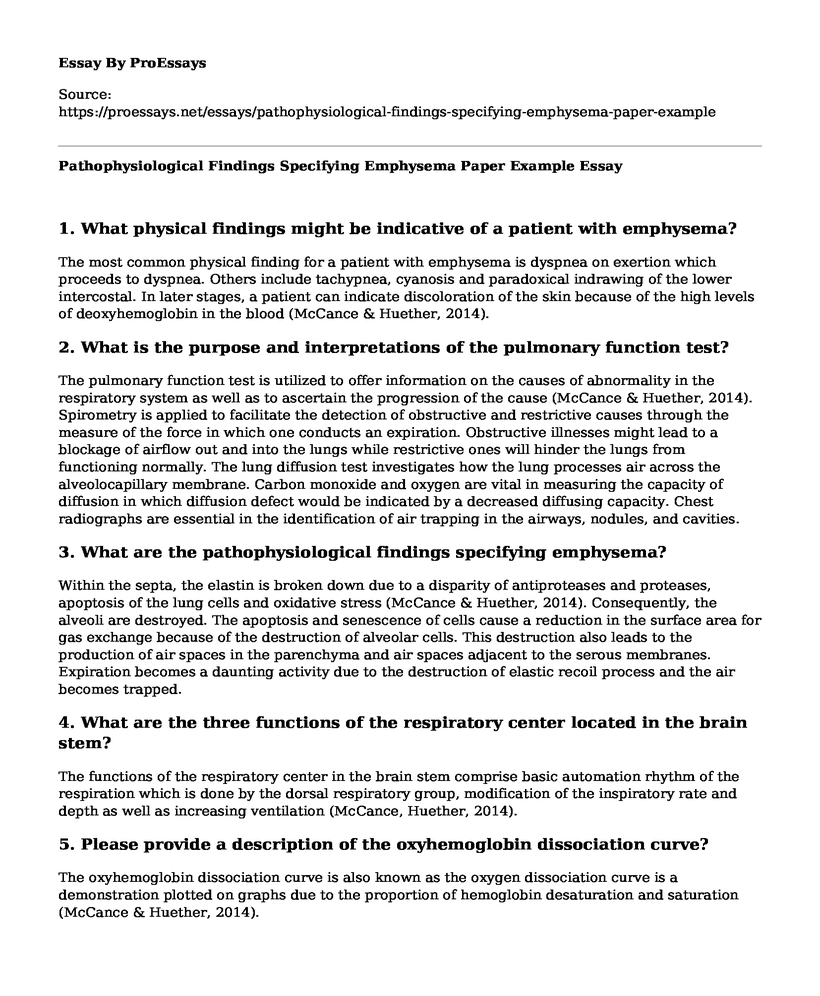1. What physical findings might be indicative of a patient with emphysema?
The most common physical finding for a patient with emphysema is dyspnea on exertion which proceeds to dyspnea. Others include tachypnea, cyanosis and paradoxical indrawing of the lower intercostal. In later stages, a patient can indicate discoloration of the skin because of the high levels of deoxyhemoglobin in the blood (McCance & Huether, 2014).
2. What is the purpose and interpretations of the pulmonary function test?
The pulmonary function test is utilized to offer information on the causes of abnormality in the respiratory system as well as to ascertain the progression of the cause (McCance & Huether, 2014). Spirometry is applied to facilitate the detection of obstructive and restrictive causes through the measure of the force in which one conducts an expiration. Obstructive illnesses might lead to a blockage of airflow out and into the lungs while restrictive ones will hinder the lungs from functioning normally. The lung diffusion test investigates how the lung processes air across the alveolocapillary membrane. Carbon monoxide and oxygen are vital in measuring the capacity of diffusion in which diffusion defect would be indicated by a decreased diffusing capacity. Chest radiographs are essential in the identification of air trapping in the airways, nodules, and cavities.
3. What are the pathophysiological findings specifying emphysema?
Within the septa, the elastin is broken down due to a disparity of antiproteases and proteases, apoptosis of the lung cells and oxidative stress (McCance & Huether, 2014). Consequently, the alveoli are destroyed. The apoptosis and senescence of cells cause a reduction in the surface area for gas exchange because of the destruction of alveolar cells. This destruction also leads to the production of air spaces in the parenchyma and air spaces adjacent to the serous membranes. Expiration becomes a daunting activity due to the destruction of elastic recoil process and the air becomes trapped.
4. What are the three functions of the respiratory center located in the brain stem?
The functions of the respiratory center in the brain stem comprise basic automation rhythm of the respiration which is done by the dorsal respiratory group, modification of the inspiratory rate and depth as well as increasing ventilation (McCance, Huether, 2014).
5. Please provide a description of the oxyhemoglobin dissociation curve?
The oxyhemoglobin dissociation curve is also known as the oxygen dissociation curve is a demonstration plotted on graphs due to the proportion of hemoglobin desaturation and saturation (McCance & Huether, 2014).
6. What are the pathophysiological findings specifying bronchitis?
According to McCance and Huether (2014), irritants cause the airway to inflame with penetration of lymphocytes and neutrophils into the bronchial wall. Progression in the inflammation may lead to edema and increase in the mucous glands in the epithelium of the airways. Consequently, they pile up due to ciliary function inefficiency. The lungs become at risk for pulmonary diseases. Dyspnea and progressive cough implicate the bronchospasm. Some of the risk factors include gastric reflux, cigarette smoke, and when a cough lasts for over three weeks, it is advisable to see a doctor ("Mayo Clinic", 2018).
References
Mayo Clinic. (2018). Bronchitis. Retrieved from https://www.mayoclinic.org/diseases-conditions/bronchitis/symptoms-causes/syc-20355566
McCance, K., & Huether, E. (2014). Pathophysiology: The biologic basis for disease in adults and children (7th ed.). St Louis, MO: Mosby
Cite this page
Pathophysiological Findings Specifying Emphysema Paper Example. (2022, Jul 08). Retrieved from https://proessays.net/essays/pathophysiological-findings-specifying-emphysema-paper-example
If you are the original author of this essay and no longer wish to have it published on the ProEssays website, please click below to request its removal:
- Outline for Argumentative Essay: Vaccines Are Linked With Autism
- CNO Standards in Nursing - Essay Sample
- Paper Example on Angela & Bridgette: Foodborne Illness From Chicken Fajita Leftovers
- Essay on Improving Understanding of Genetic Counseling for Hereditary Breast and Ovarian Cancer Clients
- Research Paper on Nursing: A Global Perspective - US & China Reforms
- Paper Sample on Abortion in China: Understanding the Rapid Change
- Social Work Ethics and Values Essay Example







